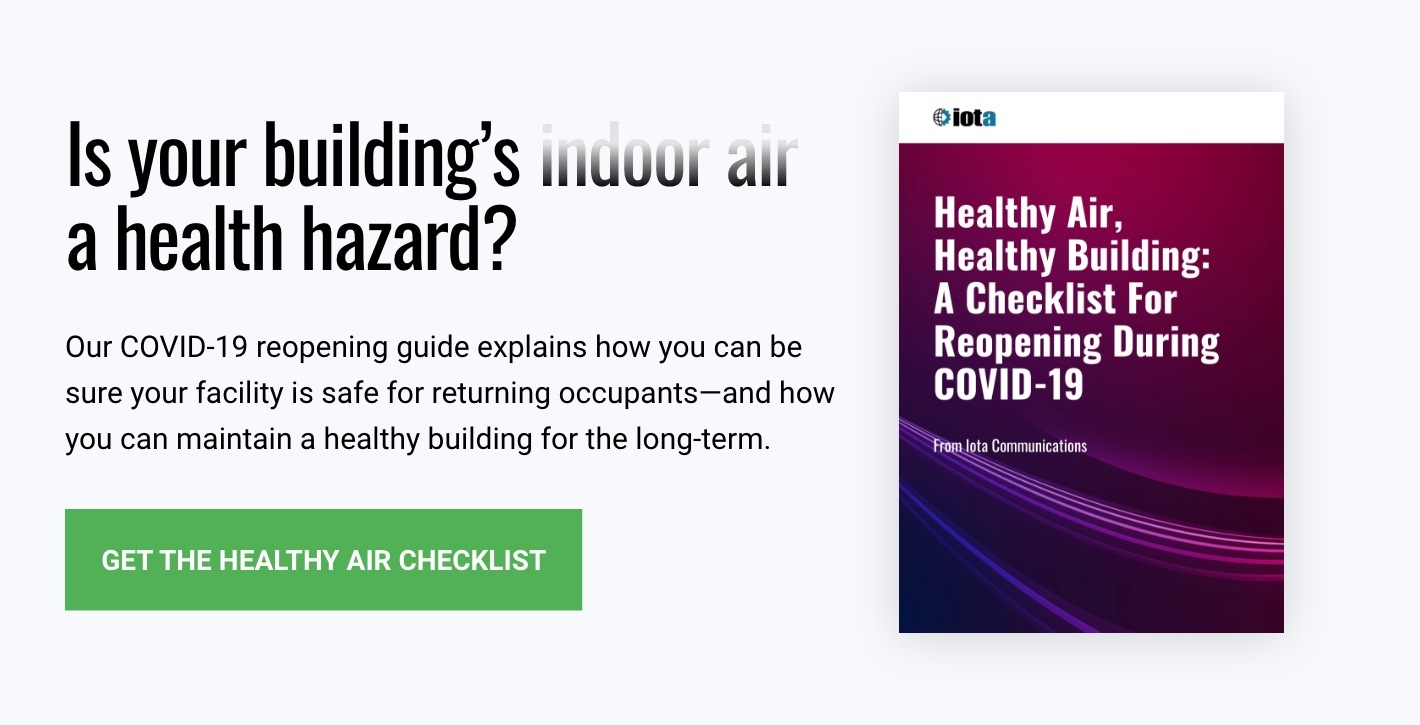The Occupational Safety & Health Act requires that employers provide a safe workplace. Before COVID-19, regulating workplace hazards largely revolved around things like providing proper training, posting appropriate signage, offering protective equipment, and other, similar elements. With the onset of COVID-19, there’s a new dimension to the importance of safety at the workplace: being proactive to reduce the spread of SARS-CoV-2.
But the pandemic isn’t the only reason to get behind health and safety at your facility. There are several reasons why building managers are pursuing a broad range of healthy initiatives for their buildings; we outline those reasons in the article below. When the current challenge passes (and we believe it will!), you’ll be glad you invested in your occupants’ well-being—and the future of your business!
Need help ensuring your building is safe to reopen? Ask us how our indoor air quality sensors can make you aware of issues you wouldn’t otherwise detect.
The Importance Of Safety At The Workplace
A “safe” workplace is about more than just preventing falls and other incidents; it’s also about creating an environment that won’t make people sick. Physical aspects of your building—such as lighting and indoor air quality—are crucial to helping people feel comfortable, healthy, and productive. Both are aspects emphasized by the WELL Building Standard, a set of guidelines that focuses on building performance in relation to human health.
Indoor air is typically 2 to 5 times more polluted than outdoor air, even in cities.
Indoor air is of particular concern. Not only is indoor air circulation associated with disease transmission, but poor quality air can cause sick building syndrome (SBS), an illness that can be directly attributable to airborne building contaminants. Anywhere from 10% to 25% of buildings in the U.S. have been linked to SBS. In our view, indoor air quality is an equally significant aspect of building health and safety.
To that point, beyond the typical benefits associated with safety in the workplace in the traditional sense, below is a list of expanded benefits that result from maintaining good air quality in the workplace.
1. Good air quality promotes employee health.
Indoor air quality has become a concern in recent years, first as cases of SBS began to emerge, and then as the role of HVAC was noted with regard to virus transmission. Additionally, studies have linked particulate matter in the air to numerous respiratory ailments, including asthma, respiratory inflammation, decreased lung function, and cancer.
Ensuring your employees work in a clean, safe environment is well worth the effort. Occupants of buildings with good indoor air quality have been shown to have reduced instances of SBS-related symptoms and reduced absences. And changing your HVAC configuration to bring in more fresh air is likely to help minimize the risk of COVID-19 transmission, keeping employees healthy—and coming back to work.
Cleaning Agents: Are they helping or hurting your occupants?
While cleaning and disinfecting are key to slowing the spread of COVID-19, be aware that they can sometimes have negative health effects. Some cleaning products emit harmful chemicals such as volatile organic compounds (VOCs), which are one of the main causes of indoor air pollution. Short-term exposure to VOCs can cause symptoms such as upset stomach, difficulty breathing, and watery eyes. Long-term exposure can potentially cause nerve damage, neurological problems, or other issues.
Monitoring your building’s indoor air quality will give you insight into whether your cleaning activities are producing a dangerous level of VOCs, and also provide you with the detailed information you need to help you keep pollutants under control going forward.
2. Healthy air promotes employee productivity.
Just because you can’t see the air around you doesn’t mean it’s not there—and having a significant impact on employee well-being. Pollution, whether indoors or outdoors, has implications on health that extend to productivity. Daily fluctuations in air quality might only have a minor effect, but prolonged work in an unhealthy environment will cause productivity to decline over time.
[bctt tweet=”Just because you can’t see the air around you doesn’t mean it’s not there—and having a significant impact on employee well-being.” username=”iotacomm”]
An overwhelming number of studies show that a better workplace environment promotes employee satisfaction, engagement, and productivity. You’re also likely to see a reduction in absences and less turnover as a result of a healthier environment. You can start to make improvements simply by monitoring your indoor air quality, as well as tailoring your lighting for specific spaces and increasing access to natural light.
3. A healthy environment saves money.
When translated into economic terms, the impact of poor indoor air quality is indeed staggering. Numerous studies have produced some compelling findings:
- When exploring the link between indoor air quality, physical wellness, decision-making, and employee productivity, simply doubling the ventilation rate can improve productivity rates equal to an amount of $6,500 per person per year.
- Because payroll and other labor expenses are 10 times larger than utility bills in commercial buildings, a 1% improvement in office productivity is comparable to a 10% improvement in energy efficiency and water efficiency.
- One company striving for WELL certification demonstrated a positive ROI outcome within three months by calculating reductions in sick leave and attrition alone.
- Poor air quality results in $150 billion of illness-related costs per year in the U.S. Of that, $93 billion represents lost productivity from headaches, fatigue, and irritation associated with sick building syndrome.
4. A focus on health & safety improves your company’s reputation.
As people become more aware of air quality and other issues related to workplace health and safety, they’re also becoming more demanding of their places of employment. While this sentiment encompasses a broad range of items (it extends to things like food choices, sit/stand desks, fitness options, and more), it also applies to air quality—which is simply another aspect of the building that empowers them (or not) to do their best work. Thus, another important benefit of health and safety in the workplace is reputation. Today’s young people, in particular, are concerned about healthy environments and are more likely to stay longer at companies that realize the importance of safety at the workplace, and are focused on employee health and well-being.
How To Achieve A Healthy Workplace
It might seem impossible to manage an invisible aspect of your building environment like air quality, but there is a simple way for building managers to “see” and even control it.
Sensors are capable of detecting and measuring certain characteristics of air quality, giving you detailed visibility into your building’s environment. This type of environmental monitoring system is simple to implement; here’s how it works:
- Place air quality sensors strategically throughout your building. The EPA recommends one sensor for every 10,000 square feet. Sensors are capable of detecting and measuring certain characteristics of air quality that indicate if the environment presents a high or low risk for airborne virus transmission; sensors can also measure other characteristics such as formaldehyde, bioaerosols, VOCs, and more. Your specific concerns (and the activities taking place within your building) will dictate what is appropriate to measure.
- The sensors continuously monitor the air; some take samples every 15 minutes. (Not all sensors function the same way.) If you’re working with an Internet of Things company like Iota, your indoor air quality monitoring equipment will send the sensor data to the cloud, where you can access it via software.
- You get immediate, real-time access to the monitoring results via a dashboard, which turns the data into visual charts that are easy to decipher.
As you continue monitoring over time, the data you receive will paint an accurate picture of your building’s overall air quality. Once you understand that, you’ll have the information you need to move forward: Are the conditions such that you need to take corrective action to control certain pollutants, or increase ventilation? Or, if your current conditions are within the recommended parameters, continued monitoring will help you maintain good air quality over the long term.
Interested in reaping the benefits of health and safety in the workplace?
At Iota, we can get you started on the road to creating a healthier, comfortable, and more productive building environment for employees. To find out more about our indoor air quality monitoring system and how it might work for you, contact us—we’d love to help.


